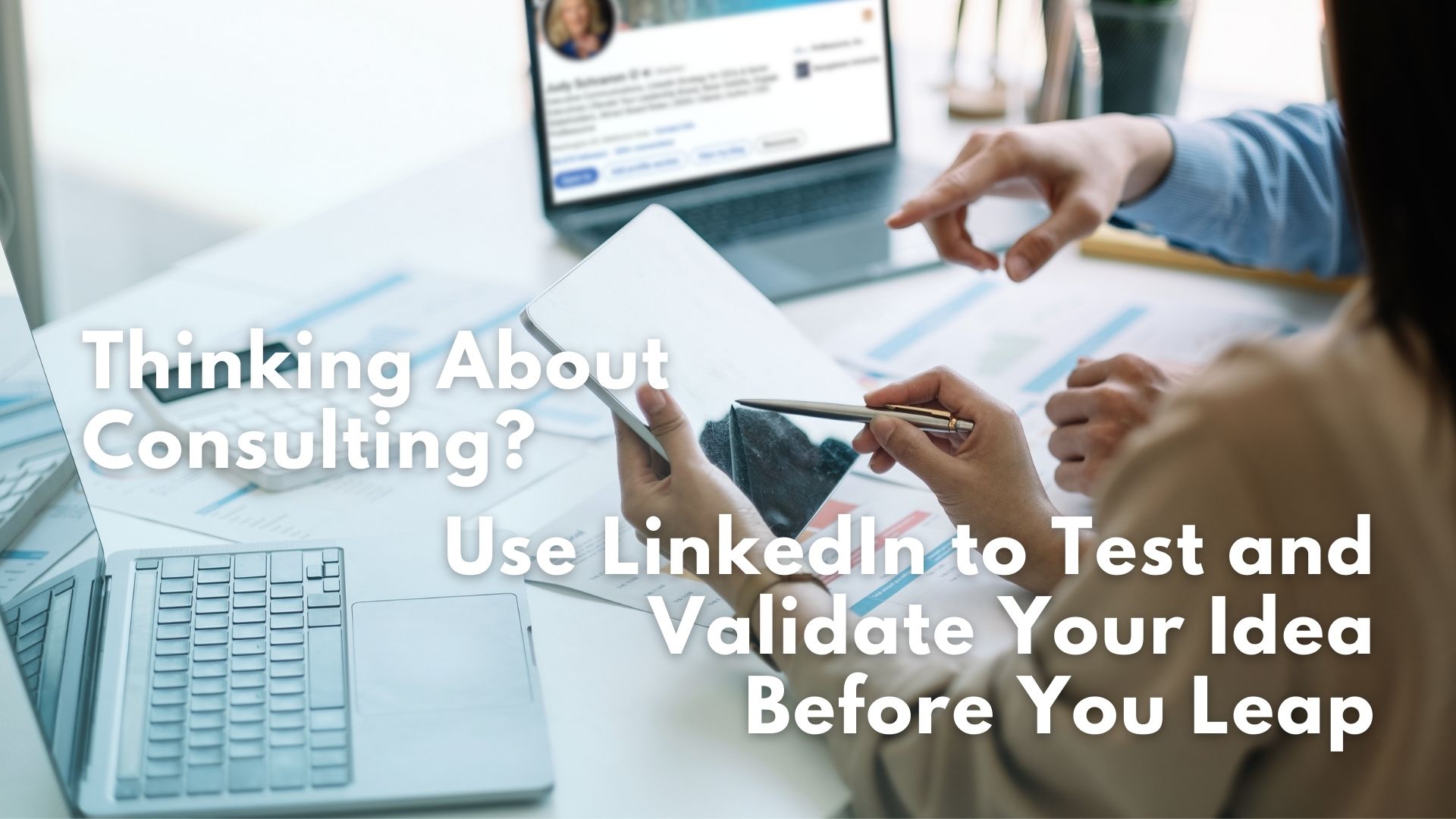If you’re a senior executive contemplating a shift into consulting, you might be asking yourself some big questions:
- Who would actually hire me—and for what?
- How do I explain what I do in a way that sparks interest?
- How can I test this idea without risking my current role or reputation?
The good news: you don’t need a website, a brand, or a big announcement to get started.
You just need a strategy to quietly test and validate your idea—and LinkedIn is the perfect place to do it.
Here’s a step-by-step approach you can use to test your consulting offer in a structured, private, and low-risk way.
Sketch Out Who You Might Help
Think of your consulting idea as a hypothesis. You’re not committing to anything yet—you’re simply exploring whether there’s demand for your skills.
- Which skills will people pay for?
- Who is most likely to be interested in hiring you?
You can find out by using LinkedIn.
To do this, start by brainstorming:
- What problems do you enjoy solving?
Example: Streamlining operations, preparing for scale, improving delivery execution, post-merger integration.
- Who has those problems and might hire you?
Example: founders of SaaS startups, COOs of healthcare organizations, CEOs of mature companies doing a turnaround or preparing to sell their business.
Now, go through your contacts lists and see who knows people like that. Try to come up with at least ten people for each type of problem.
Send Messages to People Who Already Know Your Work
Since you’re reconnecting with people in your network who know your work firsthand, you don’t need to introduce yourself or justify your outreach. You just need to let them know what you’re exploring and how they can help.
These messages should feel personal, low-pressure, and natural.
Here’s a simple structure that works well:
- Start With the Relationship
Acknowledge the connection. This makes the message feel intentional, not transactional. For example:
- “I was just thinking about our time working together on [project]. It is still one of my favorite teams.”
- “It’s been a while since we worked together at [company], but I’ve always appreciated your perspective.”
- “I always enjoyed collaborating with you on [initiative] – you were one of the people I knew I could count on.”
- Share What You’re Exploring
Let them know you’re dipping a toe into consulting or coaching, and be specific about the problems you’re focused on:
- “I’m starting to explore some consulting work around [problem you solve].”
- “I’ve been coaching a few people on how to address [situation].”
- “I’ve been thinking a lot about how [industry/stage] companies are struggling with [pain point], and I’m doing some advisory work in that space.”
- Make a Light Ask
This shouldn’t be a pitch. You’re inviting a conversation, a referral, or feedback.
- “If you come across anyone navigating something similar, feel free to send them my way.”
- “If you’re ever up for catching up or bouncing ideas around, I’d like that.”
- “I’d value your thoughts. Would you be open to a quick call sometime soon?”
You are not selling anything. You’re simply reactivating a warm connection and planting a seed that you’re available, if and when the right opportunity comes along.
Consider It an Experiment
Put this on your calendar – tell yourself you are going to reach out to one person every day.
Keep track of who you reached out to, who responded, and who you had a call with.
Put it in a spreadsheet. Treat this as an experiment where you are collecting data.
Why do it like this?
It’s hard for most executives to reach out and send messages to their network.
When you look at it like an experiment, it becomes easier to do.
Instead of reaching out to three people and getting discouraged because no one said yes, it becomes a numbers game. When someone says no, it’s not a judgement on you. It’s data.
You are learning what works and what doesn’t.
Analyze Your Results
If you reach out to 20 people and no one schedules a call, you need to tweak something – either who you are reaching out to or the way you describe your services.
Just keep trying different things until you hit something that works.
When you find it, you’ll know you have a winning offer – and maybe your first couple clients!
Why This Works
✅ It’s fast. You can run your experiments and get meaningful results in a month (or even faster if you send out more than one message a day).
✅ It’s private. No one knows you’re testing multiple ideas. Each person sees only one message.
✅ It’s actionable. Real response data gives you confidence to move forward.
✅ It builds momentum. Even if you’re not ready to launch, this builds awareness and early interest.
Start Experimenting
Starting a consulting business doesn’t begin with a logo, a website, or a polished “offer.” It begins with curiosity, experimentation, and a few intentional conversations.
By using LinkedIn to test the waters, you learn valuable information about what people want before you take the leap.
And you’ll have real-world proof that your consulting idea is really possible.
Need help crafting your message or structuring your LinkedIn tests?
We work with senior executives to refine their positioning and build their personal brand on LinkedIn.
For executives who are considering consulting or coaching, we can write your LinkedIn profile so it works for both your current job and your side gig, design the type of experiments described above, and even execute the experiments for you. (Plus we can employ much more sophisticated outreach strategies so you get richer results faster.)
If you’re exploring a move into consulting and want expert support to get it right, let’s talk about how we can help.

